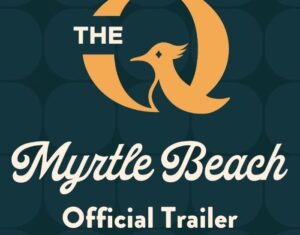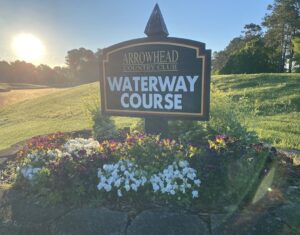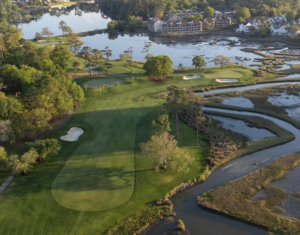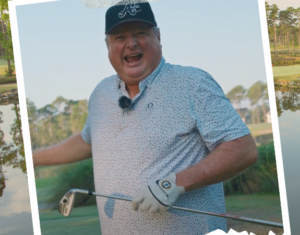The Charlie Rymer Golf Show Season 1, Episode 12: Hugh Royer III & Greg Norman Jr.
In this episode, former PGA TOUR pro Hugh Royer III is “Ridin’ with Rymer” as they discuss his life-threatening battle with cancer, and Charlie checks in with Greg Norman Jr. at his family’s Grand Strand venture at Shark Wake Park in North Myrtle Beach.
Also, in his golf tips segment, Charlie is at Eagle Nest Golf Club where he’s discussing ways to help you choose the set of tees that’s best suited for your game, and showing you one instance where playing from the cart path is not such a bad thing!
“The Charlie Rymer Golf Show” has aired on CBS Sports Network, the 24-hour home of CBS Sports that is available through all major cable, satellite and telco distributors as well as via OTT streaming service providers YouTube TV, fuboTV, DirecTV and Hulu.
Transcript
Speaker 1:
The Charlie Rymer Golf Show starring Charlie Rymer. Hey. Okay. Let’s pick up the tempo!
Charlie Rymer:
Charlie Rymer here and welcome to my new show where we do things my way. As a former golf pro and media personality, I know golf, but this isn’t going to be your grandfather’s golf show. I’m bringing you conversations with celebs and golf greats, getting off the course and out on the water and even getting into some good eats. This is The Charlie Rymer Golf Show. Keep it in the fairway folks!
Today, I’m at Myrtle Beach National taking on the King’s North with former PGA TOUR professional, Hugh Royer III. I’m Charlie Rymer, and this is Ridin’ with Rymer!
All right Hugh, we got a great golf course today. We are at King’s North here at Myrtle Beach National. I was just thinking about it as we head out on the golf course, you and I have been playing golf together for a long time.
Hugh Royer III:
30 plus years, at least. Just do me a favor, none of the old jokes and stuff. Let’s get something new.
Charlie Rymer:
That’s all I got is old jokes. This is going to be a long day for you.
Hugh Royer III:
Yeah? It’d be good though. We’ll enjoy. It’s a great golf course.
Charlie Rymer:
All right. Let’s get after it.
Hugh Royer III:
Let’s go.
Charlie Rymer:
All right. Hugh, let’s talk a little bit about your dad. He’s been gone now for five years and I know you miss him, but talk to me a little bit about some of the lessons you learned, golf and life, from your pop.
Hugh Royer III:
It was almost like having Ben Hogan as a father because he pushed hard for hard work.
Charlie Rymer:
Yeah.
Hugh Royer III:
Practice hard, work hard, outwork your opponent, and that’s the way I was raised, growing up on the tour with him, getting to know Mr. Player, Mr. Palmer, Mr. Nicklaus. You grow up around those people, so it’s an experience a lot of people don’t get to do and I got the chance to do it, so it was pretty cool.
Charlie Rymer:
You’ve been spending a lot of time these last 15 plus years now teaching. You’ve been working a lot with some younger players and you’ve been developing some players. Talk to me about a couple of your success stories.
Hugh Royer III:
Success stories, I. K. Kim.
Charlie Rymer:
Well, she can play now.
Hugh Royer III:
She can play. She is a doll. She won the US Junior, Girls’ Junior and that was a knot in the resume.
Charlie Rymer:
Now, being a player, you won four times on that Korn Ferry Tour now and made the PGA TOUR. You’re approach to teaching, having been an excellent player, is it maybe a little bit different than we see from some of the teachers that didn’t really play that much competitive golf?
Hugh Royer III:
I think it’s tremendously different, Charlie, because you can teach a golf swing and you can teach a theory so to speak, but you’ve got to be able to teach them how to use it and how to manage, and to help them understand when you stand on the 18th tee, you get nervous, you get scared, and you don’t know what to do. If the teacher has never done that, they can’t help that student.
Charlie Rymer:
Right.
Hugh Royer III:
I feel like somebody like you or I, if we did that, we can help those students realize what they need to do to succeed because we’ve been there.
Charlie Rymer:
All right. Hugh, really cool here, the six hole, The Gambler. In fact, in 1996, Mr. Palmer was here with The Gambler himself, Kenny Rogers, to dedicate this hole. My question to you is we got this island fairway on the left. If you put it in that, it makes an easy little second shot to this par 5, or do you bail out to the right? Knowing you, Hugh, you always play the sort like scared golf. You’re probably going bail out to the right place safe, aren’t you?
Hugh Royer III:
What are you smoking? You want me to lay up? I’m going right there because that right there looks really tight.
Charlie Rymer:
Come on. Let’s go. [crosstalk 00:04:05].
Hugh Royer III:
So we’re going this way.
Charlie Rymer:
All right. Let’s have at it. Oh!
Hugh Royer III:
I’m dry. I don’t know about you.
Charlie Rymer:
We’re going to have to maybe look for mine a little bit.
Hugh Royer III:
How are you going to drop this thing? Yeah, there you go.
Charlie Rymer:
I think I’m stuck. That might be pretty good there, Hugh.
Hugh Royer III:
That absolutely is really good.
Charlie Rymer:
Get up a little. I’m putting for par. You want to hit in the water. You got to be scared now.
Hugh Royer III:
Scared?
Charlie Rymer:
Oh, I’m sorry. It slipped.
Hugh Royer III:
Friends, you come out to do something like this and he’s that jealous that he’s got to mess with you.
Charlie Rymer:
I didn’t even know it was a horn. Let’s go.
Hugh Royer III:
Get it up.
Charlie Rymer:
Woo. By the way, you drop it like this.
Hugh Royer III:
The horn. You actually had to pull this.
Charlie Rymer:
You look like you got a lot of experience with that dropping.
Hugh Royer III:
You’re still putting with that brake putt?
Charlie Rymer:
Yeah, but I got to warn to where I make a putter to with it.
Hugh Royer III:
There you go.
Charlie Rymer:
Would you get that for me? I’ll be in the cart.
Hugh Royer III:
Hey, you want this?
Charlie Rymer:
Yeah. That’s a tough break. I’ll see you up on 17.
Hugh Royer III:
Unbelievably makes a 50-footer. Only him. Only him.
Charlie Rymer:
I guess, it’s what, maybe about two years ago, you got diagnosed with having melanoma.
Hugh Royer III:
Had it pop up on my right nostril. They told me it was basal cell, but they didn’t tell me it was basal cell aggressive.
Charlie Rymer:
Mm-hmm (affirmative).
Hugh Royer III:
When he comes back basal cell aggressive pattern, you’re supposed to go in every three months. The doctor told me I had three years and it scared me and I couldn’t get an answer for what it was.
Charlie Rymer:
So doctor told you got three years to live?
Hugh Royer III:
No, he said I had three years. I was fine, that I needed to come back. He told me it was nothing. Then when the bump came back, I went back to the dermatologist. He had retired. Went to the other one. He told me it was a staph infection. Never did a culture. Gave me antibiotics. It got bigger, so I wasn’t going back to him. End up going to another one. He told me it was nerve aggravation from my Oakley sunglasses.
Charlie Rymer:
And the whole time, this is cancer?
Hugh Royer III:
Yeah. That’s why the right side of my face looks the way it is. I lost a quarter of the right side of my face when they finally did the surgery. When they finally got it all, it was a centimeter from my brain.
Charlie Rymer:
My goodness. While you’re going through all of that, you can’t get out and teach or work or play golf.
Hugh Royer III:
No, nothing. It was a rough year and a half.
Charlie Rymer:
So you’ve been sharing your story with folks. Talk to me a little bit about that.
Hugh Royer III:
It’s about learning that you get out of the shower, you put deodorant on, learn to put sunscreen on the same time. And don’t be scared of doctors. If you see something doesn’t look right. Get it checked out.
Charlie Rymer:
Yeah.
Hugh Royer III:
Because if it isn’t anything, it’s no harm, no foul.
Charlie Rymer:
Ask doctors questions.
Hugh Royer III:
Because it’ll save your life. God put us here for a reason. We thought it was to play golf. For me, it was to teach people about skin cancer and how to prevent it. Now you’re going to get me emotional because-
Charlie Rymer:
Why would you think-
Hugh Royer III:
… I never thought I’d play golf again. To go out and play a mini tour event, the Sunbelt Tour and play their Match Play at the Surf Club and I won the thing.
Charlie Rymer:
Yeah.
Hugh Royer III:
It’s the first win I’ve had since my last win on the Korn Ferry Tour.
Charlie Rymer:
Emotional for me as well, knowing what you went through. Trying to get your golf game back when you’ve been dealing with life and death, that’s not very easy. Hugh, this 18 hole’s called Bullseye.
Hugh Royer III:
Yeah.
Charlie Rymer:
There’s 42 bunkers on it. I’m hoping you find about two or three of them.
Hugh Royer III:
I’m hoping you bury in the lip and can’t get out.
Charlie Rymer:
Uh-huh (affirmative). Ain’t no bunkers there.
Hugh Royer III:
That’s a pretty good one there.
Charlie Rymer:
Atta baby.
Hugh Royer III:
Let’s go see what we can do.
Charlie Rymer:
That’s two pretty good ones there. Hugh, you’ve been living here full time at Myrtle Beach 13 years now.
Hugh Royer III:
13 years, yeah.
Charlie Rymer:
You and I have been all over the world playing golf. Is there anything in the world like Myrtle Beach where we got this many golf courses in an area this tight and this many golfers that come from all over the world apply?
Hugh Royer III:
It’s very unique. It’s unique in a way, Charlie, that the golf courses work together to create packages to bring people in here. I think that’s the unique thing that makes Myrtle Beach so cool and so different than everywhere else, that whatever you want to play, you can find here.
Charlie Rymer:
Well, Hugh, we had a great day here at King’s North. You said at some point today that looked like I was putting with a brake pad. You still have the same opinion of this putter?
Hugh Royer III:
No. You got me there. You got me there.
Charlie Rymer:
It seems to work, doesn’t it?
Hugh Royer III:
Yeah. It works just fine, absolutely.
Charlie Rymer:
This is Eagle Nest Golf Club in Little River, South Carolina. It’s actually the longest golf course in the state of South Carolina, 8,168 yards of romping, stomping hell. This is a par-4 15th. It’s 505 yards. Now this is a big boy golf course. There’s no doubt about that. I got a tip for you. When you come to play here, unless you’re a big boy and you’re not, come with me, we’re going to move up a few sets of tee markers. We’re headed this way.
Charlie Rymer here, I’m playing the most fun golf courses Myrtle Beach has to offer, and I’m trying to lower your handicap along the way. So pay attention folks. The big timer is going to teach you a thing or two.
Charlie Rymer:
So this is more like it. I found a set of tee markers that’ll play about 6,800 yards. Now, I’m 53 years old, former PGA TOUR player. I can still hit the ball pretty far, but for me, 6,800 is about as much as I want to take on because I want to have a lot of fun when I play this game. I’d say most golfers find a set of tee markers at 6,000, 6,200 yards, something like that. If you’re not challenged enough, move back. You can actually play this golf course from 3,600 yards, so it’s really cool that you have all of these options here at Eagle Nest.
Charlie Rymer:
Well, that drive got away from me a little bit to the right. I’m on this cart path and I want you to check this out. A lot of people just automatically assume when you’re on a cart path, you got to take a drop. In that case, it get me over here behind this tree. I got no problem playing from the cart path. In fact, it’s going to help me out just a little bit because I need to keep this ball low underneath those trees. I’m going to take my 5-iron. It’s about 160 yards. Just put it back in my stance. Make about a three quarter swing. I’m going to shoot it right through that gap. The cart path don’t bother me one bit. Shouldn’t bother you either. That’s why they called me the Big Timer right there. Look at that shot. Whoa!
Charlie Rymer:
So after that outstanding 5-iron from off the cart path I might add, I’ve got this 15, 18-footer for birdie. Let’s talk about reading this putt a little bit. I’ve got some uphill in it and the grass looks dark to me. That means the grain’s growing towards me, so it’s going to be really easy to leave this short. Let me show you how to deal with that. When you got a putt that you know is going to be slow, find a target beyond the hole. In this case, I’ve got some left break too, so I’m going to focus my eyes beyond the hole at that tee. I’m going to forget about the hole. I’m going to roll it to that tee past the hole. Oh, sometimes you did everything right and they still don’t go in. Doesn’t mean you’re a bad person.
Charlie Rymer:
The next tip is coming to you from number 18 at Eagle Nest, and this one’s a view. 18-hole here at Eagle Nest is a par 3. I like to finish with a par 3, in particular, if it’s one as beautiful as this. What I see when I look at this hole, I see the beautiful bunkering. The three bunkers left, long, and right-
Speaker 4:
What about the water?
Charlie Rymer:
Water?
Speaker 4:
Yeah, the water.
Charlie Rymer:
I don’t see any water there.
Speaker 4:
You got a fountain.
Charlie Rymer:
The bunkers are absolutely beautiful.
Speaker 4:
You got a fountain coming out of the ground.
Charlie Rymer:
There is no water on this hole. I don’t see water at all. What I see is a beautiful hole. And you know as a matter of fact, Jack Nicklaus never remembers a bad shot, a bad round, or a bad tournament. I don’t see water. Maybe you shouldn’t either. You see what I’m doing there? No water up there. That definitely didn’t go in the water because there’s not any there. So I left myself with a straightforward pitch here at 18 and most PGA professionals would say, play the percentages. Use the putter. Your worst putt’s going to be a lot better than your worst chip. That ain’t the way we roll here on The Charlie Rymer Golf Show. I’m going to go with the power flop. That’s right. 60-degree lob wedge. I’m going to throw this sucker straight up in the air, over the sun, and land it right in the hole. Check this out. Up in the stance. Clubface wide open, full swing. That’s pretty good right there.
Charlie Rymer:
I’m in Myrtle Beach, South Carolina. This is the Shark Wake Park. Our owner, Greg Norman Jr., he’s running a little bit late. That’s how you enter a room. I played golf with Greg Norman on the PGA Tour and I thought that was exciting. This is unbelievable what Greg Norman Jr. does, unbelievable. It’s time to get me on dry land. I counted to three and you were like 20 feet up in the air, right out of the base camp over here. How in the world? That’s the thing that impressed me the most.
Greg Norman Jr.:
Yeah. The kickers and the sliders, the features out there, they’re really fun. The one thing I really love the most is the cable allows you to do, what’s called an air trick, and that’s just using pure technique and strength to be able to slingshot yourself up in the air. When you do that, people’s eyes light up.
Charlie Rymer:
Your dad’s motto, attack life, clearly the apple does not fall too far from the tree.
Greg Norman Jr.:
I appreciate that, but I’m nowhere near as good in wakeboarding as my dad was good in golf. I’m telling you right now, I was never number one in the world. My dad may not know this, but he cast a large shadow, so I had to do everything I could-
Charlie Rymer:
I’ve heard about that.
Greg Norman Jr.:
… to find my own path. This allowed me to find my own path.
Charlie Rymer:
This wakeboard thing, it couldn’t be good for the golf game. Well, that’s why I didn’t try it. If I tried it, I’d be walking around like this for a month, I think.
Greg Norman Jr.:
Well, I got some arguments against that. My dad, for example. My dad grew up surfing. Surfing is a very back, lat, abs, core, stability sport that he credits to him being able to jump into golf very quickly. Now he only started playing golf when he was 14, 15 years old and he became a scratch golfer in 18 months. But he was a surfer that entire time. That mean his body was athletic and ready to go for the golf swing that everyone knows him for and how powerful he was.
Charlie Rymer:
Similar to golf, when somebody does this the first time and they have a little success, they can’t get enough.
Greg Norman Jr.:
It’s highly addicting. Out here, it’s mental and physical. You have to get over both sides of it. Once you actually accomplish it, you get that little taste of it, you want to learn and learn and learn because in golf, as like this, there’s always something new to learn out here.
Charlie Rymer:
If floating was an Olympic sport, I would probably have a whole cabinet full of medals. I’m really good at floating.
Greg Norman Jr.:
I’m going to join you after that because I’m pretty beat off from riding.
Charlie Rymer:
But I do see a really cool green float in the middle of your lake and I see a tee box over there. Can we go give that a shot? All right, Greg, 70 yards, so you target in the middle of the lake. Here’s the competition. Got to land it on there and keep it on there, right?
Greg Norman Jr.:
If the ball just stay on the green. It’s got to stay on the green.
Charlie Rymer:
You can skip it in.
Greg Norman Jr.:
You can skip it if you want.
Charlie Rymer:
Okay. Okay.
Greg Norman Jr.:
All right.
Charlie Rymer:
If I do that first, I get a nice ball of Greg Norman I. Okay. What do you get if you win?
Greg Norman Jr.:
All right. You’re going to do a lap around the obstacle course if I get one on before you.
Charlie Rymer:
I’m motivated. You’re on the tee.
Greg Norman Jr.:
All right.
Charlie Rymer:
Oh, that’s good distance. I just pulled it.
Greg Norman Jr.:
Yeah, we hit the same spot.
Charlie Rymer:
Uh-oh. You got me scared with that one.
Greg Norman Jr.:
You’re going to hit one perfectly,-
Charlie Rymer:
I’m going to hit [crosstalk 00:18:54].
Greg Norman Jr.:
… it’s going to hit the cable.
Charlie Rymer:
Your cables are in the way. I tell you what, let’s call it a tie. We got some hits, we just couldn’t put enough spin on it.
Greg Norman Jr.:
Man, I think we’re all right. We did okay.
Charlie Rymer:
We’ll be fine.
Greg Norman Jr.:
Yeah. Will you show me that obstacle course now?
Charlie Rymer:
Let’s go have some fun over there. Here’s Shark Wake Park. This is Obstacle Island. On the starting line. Greg Norman, Jr. and his park manager, Josh. 3, 2, 1 go. Josh, don’t beat him. Wouldn’t be good for you. He’s had enough. That’s really close. That’s awesome.
Greg Norman Jr.:
Thanks, Charlie.
Charlie Rymer:
Come on up. I’m going to tell you what, that’s so much fun. Really appreciate you having us out. You got an amazing facility. We loved it.
Greg Norman Jr.:
Thank you, Charlie. Thank you for coming out.
Charlie Rymer:
You all don’t think about pulling me in because I got about a $5,000 mic on. It was hard work, not luck that got me to the PGA TOUR. I worked on every aspect of my game nearly every day. I put the time in because I was good at it and I loved it. Look for opportunities like that in life. The intersection of something you like to do and something you’re good at is one heck of a sweet spot that doesn’t feel like work. That’s it for The Charlie Rymer Golf Show. Keep it in the fairway folks!
Speaker 6:
See the numbers ticking? That means you recording and this little red-
Charlie Rymer:
Ain’t this is a union violation or something? I didn’t think talent was allowed to touch the cameras.
Speaker 6:
Good luck.
Charlie Rymer:
Are you kidding me?
Speaker 4:
That’s exactly what I was looking for. Stay right there.
Charlie Rymer:
What do you want me to do?
Speaker 4:
I want you to look-
Charlie Rymer:
Welcome back to The Charlie Rymer Golf Show. Let’s get back to fitness, folks.
Speaker 4:
Cut.



